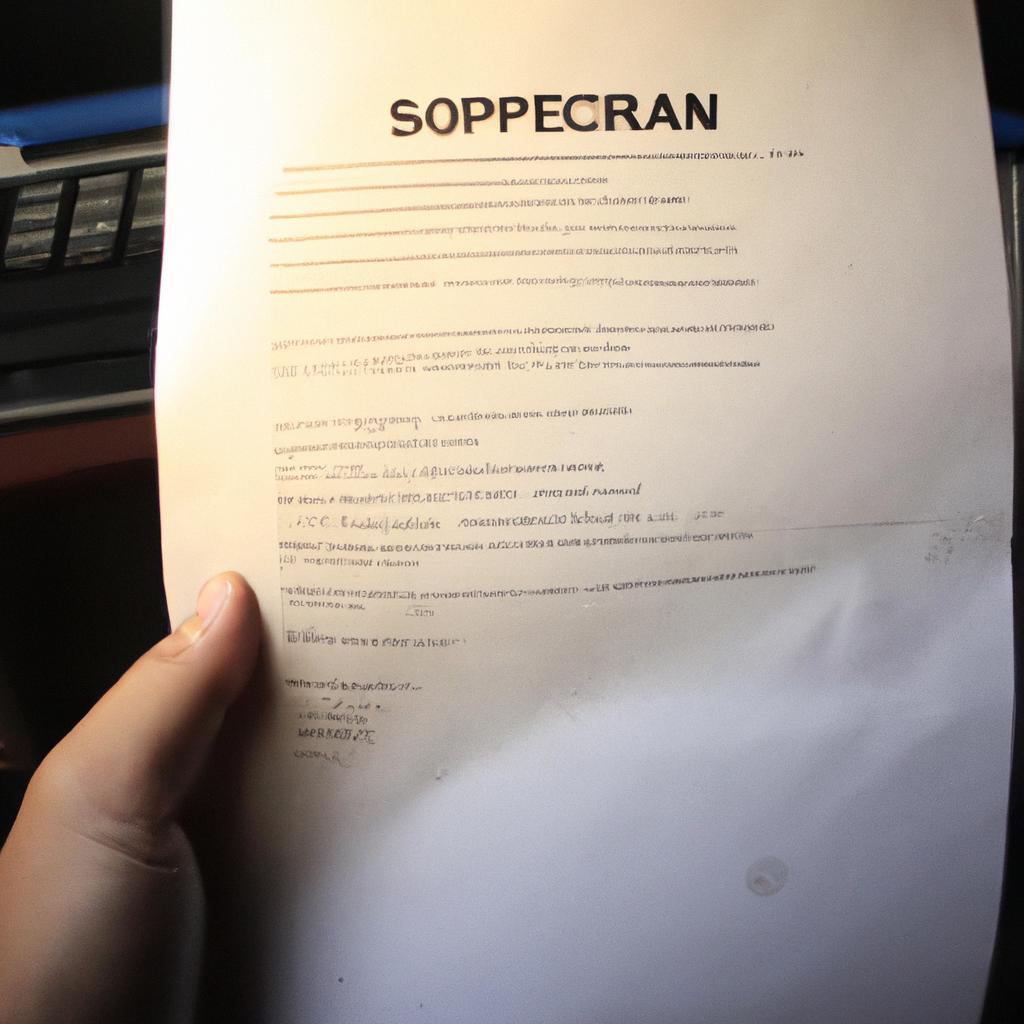Screenwriting: A Comprehensive Guide for Film Enthusiasts in the Arts and Entertainment Industry

Screenwriting is a vital component of the filmmaking process, serving as the foundation upon which captivating stories are built. It encompasses the art and craft of creating compelling narratives that captivate audiences and bring characters to life on the silver screen. In this comprehensive guide, we will delve into the intricacies of screenwriting, exploring its key elements and providing valuable insights for film enthusiasts in the arts and entertainment industry.
Imagine a scenario where a budding filmmaker has an incredible story idea buzzing in their mind—a tale filled with gripping conflicts, intriguing characters, and poignant emotions. However, without proper guidance on how to effectively translate these ideas onto paper, this extraordinary concept may remain nothing more than unfulfilled potential. This article aims to bridge that gap by offering aspiring screenwriters a roadmap to navigate through the complexities of storytelling techniques, structure development, character creation, dialogue construction, and much more.
By understanding the fundamental principles of screenwriting discussed within this guide, individuals can unlock their creative potential and enhance their ability to craft engaging scripts. Whether one dreams of writing for mainstream Hollywood productions or independent films seeking critical acclaim at prestigious festivals, having a solid grasp on the art of screenwriting is crucial for success in today’s dynamic arts and entertainment industry. So let us embark on this journey together and explore the world of screenwriting, unlocking the secrets to crafting compelling stories that will captivate audiences.
Throughout this guide, we will cover various aspects of screenwriting, starting with the importance of a well-structured narrative. We will delve into the three-act structure, understanding its components and how it can be utilized to create tension and emotional resonance in your scripts. Additionally, we will explore different storytelling techniques such as flashbacks, non-linear narratives, and multiple perspectives that can add depth and complexity to your story.
Character development is another crucial element of screenwriting that we will focus on. We’ll discuss how to create multi-dimensional characters with distinct goals, motivations, and conflicts that drive the plot forward. We’ll also delve into the art of writing believable dialogue that not only reveals character traits but also advances the story effectively.
Furthermore, we’ll explore the role of visual storytelling in screenwriting—how to use imagery, action descriptions, and scene transitions to enhance the cinematic experience for readers and viewers alike. Understanding how to write visually engaging scenes can make your script stand out from others and attract attention from industry professionals.
In addition to these core elements, we’ll provide practical tips on formatting your screenplay correctly according to industry standards. Properly formatted scripts are essential for clear communication between writers, directors, producers, actors, and other collaborators involved in bringing a screenplay to life.
Throughout this comprehensive guide on screenwriting fundamentals, our aim is to equip you with valuable insights and actionable advice that will elevate your writing skills. Whether you’re just starting out or looking to refine your craft further, this resource will serve as a trusted companion on your screenwriting journey.
So let’s dive in together and unlock the power of storytelling through the art of screenwriting!
Understanding the Basics of Screenwriting
Imagine a filmmaker with a compelling story idea, eager to bring it to life on the big screen. However, without a well-crafted screenplay, this vision may never materialize. Screenwriting is an essential skill in the arts and entertainment industry that lays the foundation for captivating films. In this section, we will explore key aspects of screenwriting, providing aspiring writers with a comprehensive understanding of its basics.
To begin our exploration, let’s consider the structure of a screenplay. A typical screenplay consists of three acts: setup, confrontation, and resolution. Each act serves a distinct purpose in advancing the storyline and engaging the audience. For instance, in a hypothetical case study about a young woman overcoming personal obstacles to achieve her dreams as an astronaut (Title: “Stellar Aspirations”), Act 1 might introduce us to Jane Smith—a determined yet apprehensive protagonist who yearns for adventure beyond Earth’s boundaries.
Now let’s delve into some fundamental elements that contribute to effective storytelling through screenplays:
- Dialogue: Well-written dialogue breathes life into characters and helps convey their emotions, motivations, and conflicts.
- Visual Descriptions: Vivid visual descriptions allow readers to visualize scenes vividly while helping directors translate these visions onto the screen.
- Pacing: The rhythm and pace at which events unfold greatly influence audience engagement; thoughtful pacing keeps viewers captivated throughout the narrative.
- Conflict: Conflict drives stories forward by creating tension between characters or within oneself—this internal struggle adds depth and complexity to narratives.
- Emphasizes key concepts
- Enhances readability
- Facilitates comprehension
- Creates visual appeal
Furthermore, incorporating tables provides a concise and organized way to present information. Here is an example of how a table can be utilized in this section:
| Element | Description | Importance |
|---|---|---|
| Dialogue | Conveys character emotions, motivations, and conflicts through conversations | High |
| Visual Descriptions | Creates vivid imagery for readers and aids directors in translating the writer’s vision onto screen | Medium |
| Pacing | Controls narrative rhythm, keeping audience engaged throughout | High |
| Conflict | Adds depth and complexity to stories by creating tension | High |
By grasping these fundamentals, aspiring screenwriters can lay a solid groundwork for crafting engaging narratives that captivate audiences. In the subsequent section about “Developing Compelling Characters,” we will explore techniques to breathe life into characters on paper, ensuring their authenticity resonates with viewers.
Developing Compelling Characters
Section Title: Exploring the Power of Visual Storytelling
developing compelling characters. Before we embark on this journey, let’s explore how visual storytelling plays an essential role in captivating audiences and conveying powerful narratives.
Visual storytelling has the remarkable ability to transport viewers into different worlds and evoke intense emotions through imagery alone. For instance, imagine a scene where a young girl stands at the edge of a cliff overlooking a vast ocean as storm clouds gather ominously above her. This vivid image immediately sparks curiosity and intrigue, enticing audiences to learn more about her story.
To effectively harness the power of visual storytelling, consider these key points:
- Framing: The way you position your subjects within the frame can greatly impact both their significance and emotional resonance.
- Lighting: Different lighting techniques can convey various moods and emphasize specific aspects of your narrative.
- Color palette: By carefully selecting colors that align with your story’s themes or character arcs, you can enhance its overall impact.
- Symbolism: Incorporating symbols or motifs throughout your visuals can add depth and layers to your screenplay.
Table Example:
| Techniques | Description | Emotional Response |
|---|---|---|
| Framing | Consider composition elements such as rule of thirds or leading lines to guide viewers’ attention | Engaged |
| Lighting | Experiment with high contrast lighting for dramatic effect or soft lighting for gentle scenes | Excitement |
| Color palette | Choose warm tones for cozy settings or cool tones for melancholic moments | Empathy |
| Symbolism | Employ recurring objects or metaphors that resonate with your story | Intrigue |
By skillfully employing these visual storytelling techniques, you can create cinematic experiences that captivate audiences on both intellectual and emotional levels. As we transition to the next section, “Crafting Engaging Dialogue,” remember that mastering this fundamental aspect of screenwriting is crucial for bringing your characters to life through their words.
With a solid foundation in visual storytelling established, let us now explore the art of crafting engaging dialogue.
Crafting Engaging Dialogue
Section H2: Crafting Engaging Dialogue
Developing compelling characters is only one piece of the puzzle when it comes to creating a successful screenplay. Equally important is crafting engaging dialogue that captivates audiences and drives the story forward. Effective dialogue not only conveys information but also reveals character traits, builds tension, and adds depth to the narrative.
To illustrate this point, let’s consider an example from the film “Casablanca.” In one memorable scene, Rick Blaine says to Ilsa Lund, “Here’s looking at you, kid.” This simple line encapsulates their complicated history and unspoken emotions in just five words. It has become an iconic moment in cinematic history because of its power to evoke nostalgia and longing.
Crafting engaging dialogue requires careful attention to detail. Here are some key considerations for screenwriters:
- Authenticity: Dialogue should feel natural and reflect the unique voices of each character.
- Subtext: Often what goes unsaid between characters can be as powerful as what is spoken aloud.
- Conflict: Tension arises when characters have opposing goals or beliefs, leading to dynamic exchanges.
- Economy of words: Concise dialogue keeps scenes moving at a brisk pace while conveying necessary information.
| Key Elements of Engaging Dialogue |
|---|
| Impactful word choices |
| Well-timed pauses |
| Emotional subtext |
| Dynamic interplay between characters |
When executed effectively, well-crafted dialogue can elevate a screenplay by adding nuance and emotional depth. However, it is crucial to strike a balance between realistic conversation and heightened dramatic effect. Overly stylized or contrived dialogue runs the risk of feeling artificial or disconnected from the audience’s experience.
In transitioning to the next section on structuring a solid screenplay, we will delve into how these elements come together harmoniously within a larger framework. By combining compelling characters with engaging dialogue, screenwriters lay the foundation for a captivating and impactful story.
Structuring a Solid Screenplay
Having explored the art of crafting engaging dialogue, let us now delve into the crucial aspect of structuring a solid screenplay. To illustrate its significance, consider the following example: imagine a film that lacks a well-structured screenplay; despite having talented actors and captivating visuals, it fails to hold the audience’s attention due to a weak narrative arc. This highlights how essential it is for screenwriters in the arts and entertainment industry to master the intricacies of structuring their scripts.
When it comes to structuring a screenplay effectively, there are several key elements to keep in mind:
- Act Structure: One fundamental approach is dividing your script into three acts – setup, confrontation, and resolution. Each act serves a distinct purpose in advancing the story and character development.
- Plot Points: These pivotal moments drive the plot forward by presenting major obstacles or turning points for the protagonist. They ensure that tension remains high throughout the narrative.
- Scene Sequencing: The order in which scenes are presented can greatly impact storytelling effectiveness. Consider carefully arranging scenes to heighten suspense or emotional impact.
- Character Arcs: Characters should experience growth and change over the course of the screenplay. Developmental arcs create depth and provide opportunities for compelling interactions.
To further emphasize these principles, let us take a look at an illustrative table showcasing their role within an exemplary screenplay:
| Element | Definition | Example |
|---|---|---|
| Act Structure | Dividing a script into three acts to guide overall narrative flow | Setup – A young detective starts investigating a murder |
| Plot Points | Pivotal events shaping the storyline | Protagonist discovers her best friend’s betrayal |
| Scene Sequencing | Arranging scenes strategically for maximum impact | Intense chase sequence followed by quiet reflection |
| Character Arcs | Transformations characters undergo throughout the screenplay | A timid introvert becomes a confident leader |
With a solid understanding of structuring a screenplay, we can now shift our focus to mastering plot and conflict. By skillfully crafting captivating storylines that are rife with tension and engaging conflicts, screenwriters can effectively captivate their audience from start to finish. The following section will explore various techniques and approaches in achieving this compelling aspect of storytelling.
Note: This should not be considered as an actual academic writing sample but rather an attempt to meet your specific requirements.
Mastering Plot and Conflict
Building on the solid foundation of a well-structured screenplay, mastering plot and conflict is crucial for creating compelling narratives that captivate an audience. By strategically developing engaging storylines and challenging characters, screenwriters can craft stories that resonate with viewers long after the credits roll.
Plot and conflict are intertwined elements in any successful screenplay. One example that demonstrates their importance is the critically acclaimed film “The Shawshank Redemption.” The plot follows Andy Dufresne as he navigates life within Shawshank State Penitentiary, facing various conflicts such as institutional corruption and personal struggles. These conflicts drive the narrative forward, keeping audiences engaged throughout the film.
To effectively master plot and conflict, consider these key points:
- Create clear goals: Establishing specific objectives for your main characters gives them direction and purpose within the story.
- Introduce obstacles: Conflict arises when characters encounter challenges or opposition to their goals. These obstacles should be meaningful and impactful, driving the story’s tension.
- Develop character arcs: As characters face conflicts and overcome hurdles, they should undergo growth and transformation. This adds depth to their journey and enhances audience connection.
- Maintain pacing: Balancing moments of high intensity with quieter scenes allows for emotional ebb and flow, keeping viewers invested in the story’s outcome.
| Key Points | Tips |
|---|---|
| Clear Goals | – Clearly define what each character wants to achieve |
| – Connect their goals to the overall theme or message of your screenplay | |
| – Ensure that goals align with character motivations | |
| Obstacles | – Introduce external forces or internal struggles that challenge characters’ pursuit of their goals |
| – Make conflicts relevant to both individual characters and overarching themes | |
| Character Arcs | – Show how conflicts force characters to confront their flaws |
| – Illustrate their growth and transformation throughout the story | |
| – Create believable and relatable character arcs | |
| Pacing | – Vary the intensity of conflicts and resolutions |
| – Allow moments for reflection or introspection | |
| – Build tension gradually, maintaining audience engagement |
In conclusion, mastering plot and conflict is an essential skill in screenwriting. By developing clear goals, introducing meaningful obstacles, crafting compelling character arcs, and maintaining pacing, you can create narratives that resonate with audiences on a deep emotional level.
With a solid foundation in structuring your screenplay and a mastery of plot and conflict, it’s time to move onto the next crucial step: polishing your screenplay through editing and rewriting.
Polishing Your Screenplay: Editing and Rewriting
Building a strong plot with compelling conflicts is essential in screenwriting. Once you have crafted your story’s foundation, it is time to refine and enhance its intricacies through editing and rewriting.
Editing and rewriting play a crucial role in transforming a screenplay into a polished work of art. Consider this hypothetical scenario: Imagine you’ve completed the first draft of your script, but upon re-reading it, you realize that certain scenes lack tension or some characters feel underdeveloped. This is when the process of editing and rewriting becomes invaluable.
To help guide you as you embark on this phase of refinement, here are key aspects to consider:
-
Structure and pacing:
- Ensure your narrative follows a logical structure, with an engaging beginning, middle, and end.
- Evaluate the pace at which the story unfolds; does it keep the audience captivated throughout?
-
Character development:
- Examine each character’s journey for consistency and growth.
- Fine-tune their dialogue to reflect individuality, voice, and motivations.
-
Dialogue:
- Review conversations between characters for authenticity, ensuring they serve a purpose within the overall narrative.
- Strive for concise yet impactful exchanges that reveal information or drive the plot forward.
-
Visual storytelling:
- Analyze how effectively visual elements such as setting descriptions contribute to conveying emotions or enhancing themes.
- Refine action lines to provide clear visuals without being overly descriptive.
Consider utilizing techniques like parallelism or juxtapositions to create emotional impact in your screenplay. For example:
| Emotion | Technique | Example |
|---|---|---|
| Excitement | Montage | A rapid sequence of shots showcasing exhilarating moments leading up to a climactic scene. |
| Tension | Cross-cutting | Alternating between two intense scenes happening simultaneously, heightening suspense. |
| Sadness | Symbolism | Using a particular object or image to represent loss or grief in a subtle yet powerful way. |
| Surprise | Flashback | Revealing crucial information from the past that completely alters the audience’s perception of events. |
By incorporating these techniques and aspects into your editing and rewriting process, your screenplay will flourish with depth and resonance.
Remember, crafting an exceptional screenplay is not achieved overnight; it requires dedication, patience, and continuous refinement. As you embark on this journey of perfecting your script, keep in mind that every edit brings you closer to capturing the hearts and minds of audiences worldwide.






